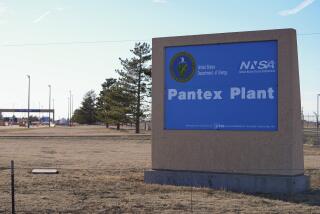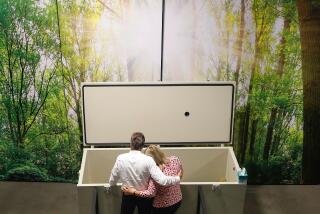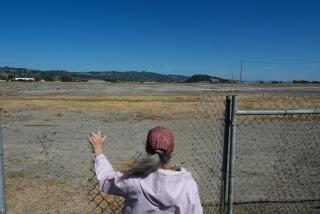After 4 years, Fukushima nuclear cleanup remains daunting, vast

Staff writer Julie Makinen reports on Japan’s effort to clean up after the 2011 meltdown of the Fukushima Dai-Ichi nuclear plant. The work so far has cost $13 billion.
Reporting from Minamisoma, Japan — Neon pink and yellow banners flutter along the roadsides, their gentle flapping breaking an eerie stillness. The houses here are shut tight, the streets are nearly deserted, the fields that once sprouted rice, tomatoes and cucumbers are fallow.
Shigeo Karimata dons a hard hat and a mask and prepares to get out of his car.
“Some people say, ‘Oh, it looks like a festival!’” says the avuncular 62-year-old Environment Ministry worker. “Then they see the writing on the flags: ‘Decontamination Work in Progress.’”
A colleague pulls out a radiation-measuring machine. “0.29 microsieverts,” he says, looking at the readout. “Not too high.”
Karimata is in charge of the work here in an evacuation zone about 12 miles north of the Fukushima Dai-ichi nuclear plant—part of the most extensive, and expensive, nuclear cleanup ever attempted.
The scale and complexity of what Japan is trying to do in the aftermath of the 2011 meltdown at Fukushima is mind-boggling. Decontamination plans are being executed for 105 cities, towns and villages affected by the accident at Fukusima Dai-ichi, 140 miles northeast of Tokyo.
Many Japanese regard this massive undertaking as a solemn obligation to right a terrible wrong. Others, even some of the people directly affected, question whether it’s a quixotic waste of resources.
Karimata’s delegation marches up a side street to check on a brigade of laborers wearing gloves, masks, helmets and fluorescent vests with radiation detectors tucked in their chest pockets. Some are spreading fresh soil in the yard of an uninhabited home. Next door, workers are up on a scaffold, preparing to wipe down the roof and gutters.
Across the street, near a bamboo grove, two men are erecting a plastic frame to support a massive double-lined garbage bag about the size of a hot tub. Dozens of identical black sacks, each weighing about a ton and stuffed with radiation-contaminated soil, leaves, wood chippings and other debris, stretch out behind them, awaiting transport at some uncertain date to a yet-unspecified final resting place.
Four years after the Great Tohoku Earthquake shook northern Japan to its core, touched off a deadly tsunami and precipitated the Fukushima Dai-ichi disaster, hundreds of square miles remain off-limits for habitation due to radioactivity. Some 79,000 people still cannot return home.
But unlike the 1986 accident at Chernobyl, where authorities simply declared a 1,000 square-mile no-habitation zone, resettled 350,000 people and essentially decided to let the radiation dissipate over decades or centuries, Japan is attempting to make the Fukushima region livable again. It is an unprecedented effort.
++
The sheer manpower and money dedicated to the house-to-house effort is staggering: In the last four years, the government has spent $13.5 billion on decontamination efforts outside the nuclear plant, and the budget request for the fiscal year starting in April is another $3.48 billion, said Seiji Tsutsui, director of the international cooperation office for radioactive decontamination at the Environment Ministry.
At the peak, some 18,000 people were doing decontamination work; as of early February, that number had dropped to 12,000. But around Minamisoma, there are still so many workers that residents in the northern part of town – which is not under evacuation orders – complain of heavy traffic as laborers commute to job sites and orange, yellow and turquoise backhoes and other equipment is moved from field to field.
The fruits of the laborers’ efforts are stacked in those giant sacks—5.5 million of them and counting. They are spread out across Fukushima province, along roadsides, in parking lots and backyards. They are tagged and bar-coded so authorities know what’s inside and how radioactive it is – and when the bags might start to wear out.
As the bags pile up and workers fan out across the landscape, some locals are questioning the cost-benefit analysis.
“Decontamination – the activity is endless. The huge amount they are spending, maybe it would be better spent helping residents” resettle elsewhere, says Iwao Hoshi, a former city official in Minamisoma. Unlike tsunami victims whose homes were ruined and realized they had to move on, he says, many radiation evacuees are stuck in limbo, knowing their homes are still standing.
After the disaster, Hoshi coordinated shelter programs but quit government life after his bosses asked him to resume his duties in the tax department a year later. “Sometimes I think the decontamination project is run by the sales department of general contractors,” he adds, puffing on a Lucky Strike cigarette.
Even before the disaster, the region was rapidly aging and losing young residents to Tokyo and other urban centers. Many of those who want to return home are senior citizens. Decontamination efforts may allow them to go back, but there’s little guarantee that their communities won’t die out anyhow within a few decades.
“Some people have already given up. I don’t think most people will come back,” concedes Karimata. “After the evacuation, many people wanted to return, but it’s been four years, and now it’s maybe half. The longer it takes, the more the numbers will be reduced.”
++
Karimata, who spent his career doing rural development with the Agriculture Ministry and worked in hardship posts including Pakistan and Ethiopia, hovers over a map showing the evacuation zone. Pink areas are places the government says residents “will have difficulties returning for a long time” and cannot go without permission; green and yellow areas have lower radiation, and people can enter during the daytime but not stay overnight. That’s where the work brigades have been dispatched.
Twenty thousand people from Minamisoma remain evacuated, and Karimata has until March 2016 to decontaminate 5,000 houses and yards in his zone of responsibility. So far, they’ve finished just 360. He has 3,300 workers in Minamisoma, and another 1,000 in the adjacent town of Namie; they’re working six days a week. “This kind of work is new for everyone,” he says.
Besides Karimata’s district, there are four other branch offices in charge of other zones.
In addition to wiping down roofs, gutters and walls, the workers scrape several inches of soil off the most contaminated farmland and replace it. Less-contaminated ground is “turned over” to a depth of 12 to 16 inches. Forest areas are also being attended to as well—within 65 feet of homes. That work is complex, Karimata says, because radioactive material fell on leaves in 2011, and those leaves then dropped to the ground, and have been covered over by several more seasons of detritus.
“Now, if you remove the top layer, radiation actually goes up. There’s also an erosion problem,” he says. “Many people want us to do the whole forest, but it’s expensive and can create more dangers than we have now.”
Both Chernobyl and Fukushima were classified as “level 7” nuclear events, but the amount of radiation released into the atmosphere at Fukushima was dramatically less than at Chernobyl, and part of what was released blew out to the Pacific Ocean and did not fall on land.
A report by the U.N. Scientific Committee on the Effects of Atomic Radiation in October found the public health effects of the Fukushima accident to be much less severe than at Chernobyl. The panel predicted cancer rates would remain stable, and foresaw no impact on rates of birth defects, though there was a “theoretical” increased risk of thyroid cancer among the most exposed children.
Still, Edwin Lyman, co-author of “Fukushima: The Story of a Nuclear Disaster,” said the thoroughness of decontamination work would have a bearing on ultimate outcomes. “A significant part of the radiation dose to the public is still in the future,” after evacuation orders are lifted, he said. “It will depend on what standards are set.”
In the long term, Japan’s target is to reduce radiation in decontaminated areas to less than 1 milliSievert per year on top of normal background levels.
The Environment Ministry wants to wrap up the cleaning brigades by 2017, but where to put all the material they’ve collected remains a vexing challenge. Authorities recently started construction on a massive specialized landfill in a pink zone just outside the Fukushima Dai-ichi plant. When complete, it is expected to hold between 16 million and 22 million bags of debris – enough to fill about 15 baseball stadiums.
Although construction has begun on the so-called Interim Storage Facility, not all the landfill area has been secured from the owners, who are reluctant to sell their property even as they realize returning to that area in their lifetimes remains highly unlikely.
“People love their land and don’t want to release it,” said Tetsuya Nakashima, director of the project for the Environment Ministry. “This is their personal land, and they want it clean too.”
Further community consultations will be necessary on issues such as transport routes and safety plans, said Nakashima. The national government has promised that the material will be disposed of “outside of Fukushima” after 30 years, but hasn’t determined where that might be.
++
Even if all those details could be worked out immediately, there is still the question of just how to get millions of bags of radioactive debris to the landfill. A 10-ton truck can only carry seven bags at a time. At that rate, transport could take decades. Material might have to be put into fresh bags if they start to break down before they can be moved.
Tatsuhiko Kodama, director of Tokyo University’s Radioisotope Center, who has been recruited by Minamisoma to chair its Committee to Promote Decontamination, says the government’s plan is “nearly impossible” and makes no sense.
“The government is simply putting soil into bags with no plan for recycling,” said Kodama, who has been visiting the area on a weekly basis. “The residents don’t trust the government so much.”
Only if the material is condensed will it be possible to gather it in a central location, Kodama believes.
Kodama believes some decontamination of bagged waste can be done locally. To that end, he has been trying to encourage authorities to build local waste recycling facilities that heat soil to high temperatures to remove radioactive material like cesium. A demonstration project that can process 10 tons a day has already been built in Iitate, a ghost town just west of Minamisoma that just before the disaster had been named one of Japan’s most beautiful villages.
For now, Karimata’s brigades are laying down sand and waterproof sheeting on a 50-acre plot that used to be a rice field; the area will hold 400,000 of the one-ton bags for about three years, officials said, before they are presumably moved again.
Karimata knows he’s in a bit of a race against time. “The old people, the evacuees, they are stressed and want to come back so I want to help make that happen,” he says.
“This work is very important. At the end of my career, I’m happy to be doing this. It will be recorded in history, and maybe 100 years from now my descendants will feel proud.”
Follow @JulieMakLAT for news from Asia
More to Read
Sign up for Essential California
The most important California stories and recommendations in your inbox every morning.
You may occasionally receive promotional content from the Los Angeles Times.











